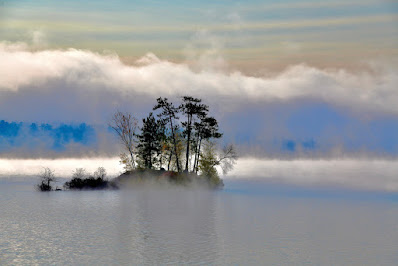 |
| Sunrise over Moose Pond Bridgton |
Can photography be considered fine art? That depends on what one thinks art is, and I suspect there are differing opinions. Few would disagree that Michaelangelo and Da Vinci were artists, but what about Ansel Adams?
Last summer I applied as a photographer to Gallery 302, a cooperative art gallery in Bridgton, Maine and was accepted. Everyone exhibiting there is called an artist, but not all the three dozen or so “artists” agree with that designation for photographers. Everyone has to contribute in some way to the functioning of the gallery, so when the gallery president discovered I was a columnist, she asked me to write up something to answer the question that opens this column.
 |
| Autumn sunrise Eastman Hill, Lovell |
I’m comfortable calling myself a photographer, and I guess I’m a professional photographer too since people have paid me tens of thousands in exchange for hundreds of my photos, but I’m not completely comfortable calling myself an artist. Ansel Adams said once that: “Art implies control of reality, for reality itself possesses no sense of the aesthetic. Photography becomes art when certain controls are applied.”
 |
| Ansel Adams |
Whoever thinks, even for a few seconds, before snapping a shutter is “applying certain controls.”
 |
| Ansel Adams |
Aesthetic” means “is concerned with beauty or the appreciation of beauty.” As for the controls he applied, Adams liked his images sharp with broad tonal range, and his best-known work was in black-and-white. Although that medium doesn’t grab me, I see they’re good. His less-well-known color images, however, are stunning. After viewing those, I have no trouble calling Adams an artist. When he talks about “a sense of the aesthetic” he’s talking about beauty — and that is experienced on a feeling level.
 |
| Crystal Lake Harrison, Maine |
If I should photograph a document with my iPhone, for example, there’s no feeling involved; it’s a utilitarian gesture. But when I pull over somewhere to photograph a tree, a landscape, a sunrise or a sunset with a DSLR, I’m perceiving beauty and attempting to capture some of it. I’m compelled to preserve as many aspects of it as I can, for myself and for others with whom I may share my images.
 |
| Autumn sunset Lovell, Maine |
Beauty is often fleeting. Certain kinds of light render it visible, enhance it. Whatever I see when I pull over can disappear by the time I get my camera out of its bag, turn it on, set the aperture, zoom in our out, and focus. It only takes a second for the light to change. As Darylann Leonard, one of the other photographers exhibiting at Gallery 302 put it: “In my opinion a lot of work goes into a shot -- studying the light, driving around for hours scouting locations, going to a location 20 times before getting a shot that is worth processing, spending hours hiking to get different perspectives, spending hours in the cold, spending a lot of time and thought to compose an image, getting up at early hours to catch the good light etc…”
 |
| By Darylann Leonard |
She’s right of course. I’ve done those things too and it is work, but not in the sense of drudgery. It’s work I love to do. There can be frustrations when the light changes just as I’m getting ready to shoot, but the payoff after getting it right is extremely satisfying. Sometimes I’m very lucky to stumble onto a beautiful scene and capture it right away with little effort. Painters, too, often use a camera and then paint from the photo — emphasizing this, leaving out that, mixing colors to either match the photo or enhance it.
 |
| My wife Roseann's garden |
Today’s high-end digital cameras capture lots of details in a “file” that require sophisticated editing software to bring out. The software can also make the photo look like a watercolor, or oil painting, or nearly any other kind of rendering imaginable. As Darylann put it: “The second dimension is processing. I think photographers develop styles of [digital] processing similar to dark room days. [They] study the execution of bringing out certain dynamics [buried in] an image. So I guess my argument would be that photographers most definitely can fit into the category of fine art, but in [our] own unique way[s] — just as there are different media for painters.”
 |
| 17,000-year-old cave painting Lasceaux, France |
Though I had no aptitude for either, I admired fellow students in third grade who showed talent for drawing and painting. Once I tried to copy an image of a robin on a tree branch, and I still recall how good it felt when my effort crudely approximated the original. Image-making is an urge inside all of us, and always has been. Seeing the 17,000-year-old cave paintings of Lasceaux, France, I feel a connection with the artists who created them so long ago. The act of image-making is rewarding in itself, independent of any pecuniary benefit that may result.




4 comments:
Beautiful photos!
Like I’ve said before, Lovell is “God’s country”.
“I’ve seen hundreds of bad paintings and hundreds of bad photographs, it takes someone with dedication, skill and personal perspective of what it is they want to achieve to take an artistic photograph.” -James Ellis. https://www.lightstalking.com/photography-art/
I MUST be a photographic artist!
I've gone through yards of Tri-x in bulk, reams of polycontrast paper, with filters, dodging and burning.
I think I've had TWO prints with which I was mostly satisfied.
Congratulations Captain.
Post a Comment